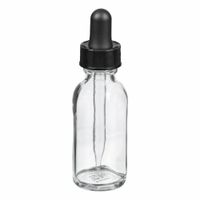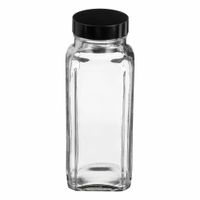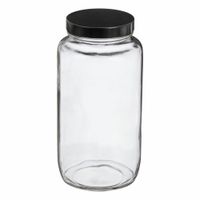Call +(254) 703 030 000 / 751 483 999 / 721 704 777
- Home
- Lab Supplies
- Plastic Glass Containers Closures
- Glass Lab Containers
- Glass Lab Bottles
.....Read More
Frequently Asked Questions
What are the advantages of using glass bottles in laboratories?
Glass bottles offer several advantages in laboratory settings:
1. **Chemical Resistance**: Glass is highly resistant to a wide range of chemicals, including acids, bases, and solvents, making it ideal for storing and handling various substances without risk of reaction or contamination.
2. **Thermal Stability**: Glass can withstand high temperatures and sudden temperature changes, allowing it to be used in processes involving heating or cooling without risk of melting or deforming.
3. **Non-porous Surface**: The smooth, non-porous surface of glass prevents absorption of liquids and gases, reducing the risk of contamination and making it easy to clean and sterilize.
4. **Transparency**: Glass is transparent, allowing for easy visual inspection of contents, which is crucial for monitoring reactions, measuring volumes, and ensuring the correct substances are used.
5. **Inertness**: Glass is inert and does not interact with most substances, ensuring that the contents remain pure and uncontaminated.
6. **Durability**: While glass can break, it is generally durable and can be reused multiple times, making it a cost-effective option in the long run.
7. **Environmental Impact**: Glass is recyclable and can be reused, reducing waste and environmental impact compared to single-use plastic containers.
8. **Regulatory Compliance**: Glass bottles often meet regulatory standards for laboratory use, ensuring safety and compliance in scientific research and industrial applications.
9. **Versatility**: Available in various shapes and sizes, glass bottles can be used for a wide range of applications, from storage to reaction vessels.
10. **Non-reactivity with Light**: Amber or dark-colored glass bottles protect light-sensitive substances from degradation, maintaining the integrity of the contents.
How do glass bottles compare to plastic bottles in terms of temperature resistance?
Glass bottles generally have superior temperature resistance compared to plastic bottles. Glass can withstand a wide range of temperatures without deforming or degrading. It can handle both high temperatures, such as those encountered during sterilization processes, and low temperatures, such as freezing, without losing its structural integrity. This makes glass bottles ideal for applications requiring thermal stability, such as storing hot liquids or being subjected to rapid temperature changes.
In contrast, plastic bottles, depending on the type of plastic, have more limited temperature resistance. Common plastics like PET (polyethylene terephthalate) and HDPE (high-density polyethylene) can deform or release harmful chemicals when exposed to high temperatures. PET bottles, for example, can start to deform at temperatures above 70°C (158°F), making them unsuitable for hot liquids. Some plastics can also become brittle at low temperatures, increasing the risk of cracking.
Additionally, glass is non-reactive and does not leach chemicals into its contents, even when exposed to temperature extremes. This is a significant advantage over certain plastics, which may release substances like BPA or phthalates when heated.
Overall, glass bottles offer better temperature resistance and chemical stability, making them a preferred choice for applications where these factors are critical. However, they are heavier and more fragile than plastic, which can be a disadvantage in terms of transportation and handling.
What types of glass bottles are available for laboratory use?
Laboratory glass bottles come in various types, each designed for specific applications and requirements. Here are the main types:
1. **Reagent Bottles**: Also known as media bottles, these are used for storing chemicals, reagents, and media. They often have a wide mouth for easy pouring and are available in clear or amber glass to protect light-sensitive contents.
2. **Volumetric Flasks**: These are used for precise dilutions and preparation of standard solutions. They have a flat bottom, a long neck, and a single graduation mark for accurate volume measurement.
3. **Bottles with Screw Caps**: These bottles are designed for secure storage and transport of liquids. The screw cap ensures a tight seal, preventing leaks and contamination.
4. **Dropping Bottles**: Equipped with a dropper or pipette, these bottles are used for dispensing small amounts of liquid. They are ideal for titration or adding reagents dropwise.
5. **Aspirator Bottles**: These are large bottles with a spigot at the bottom, used for dispensing liquids by gravity. They are often used in filtration processes.
6. **Wash Bottles**: Typically made of plastic, but glass versions are available for use with solvents that may degrade plastic. They have a nozzle for directing a stream of liquid, often used for rinsing.
7. **Amber Glass Bottles**: These are used to store light-sensitive chemicals. The amber color protects the contents from UV light degradation.
8. **Graduated Bottles**: These bottles have volume markings for approximate measurements. They are useful for general laboratory tasks where precise volume is not critical.
9. **Safety Coated Bottles**: These have a protective plastic coating to contain glass shards and contents if the bottle breaks, enhancing safety in the lab.
Each type of bottle is chosen based on the chemical compatibility, required volume, and specific laboratory application.
How can glass bottles be sterilized between uses?
Glass bottles can be sterilized between uses through several methods:
1. **Boiling Water**: Submerge the bottles in a large pot of water, ensuring they are completely covered. Bring the water to a boil and maintain it for at least 10 minutes. Carefully remove the bottles using tongs and place them on a clean, dry surface to air dry.
2. **Steam Sterilization**: Use a steam sterilizer, commonly available for baby bottles. Place the bottles inside the sterilizer, add water as per the manufacturer's instructions, and run the cycle. This method is effective and convenient for small batches.
3. **Dishwasher**: Use a dishwasher with a high-temperature setting or a sterilization cycle. Ensure the bottles are placed upside down to allow water to drain. This method is suitable for heat-resistant glass bottles.
4. **Oven Sterilization**: Preheat the oven to 275°F (135°C). Wash the bottles with soap and water, then place them on a baking sheet. Heat in the oven for 20 minutes. Allow them to cool inside the oven to prevent thermal shock.
5. **Chemical Sterilization**: Use a food-safe sterilizing solution, such as a diluted bleach solution (1 tablespoon of bleach per gallon of water). Soak the bottles for at least 2 minutes, then rinse thoroughly with boiled or distilled water to remove any residue.
6. **Autoclaving**: For industrial or laboratory settings, autoclaving is a reliable method. Place the bottles in an autoclave and run a cycle at 121°C (250°F) for 15-20 minutes under pressure.
7. **UV Sterilization**: Use a UV sterilizer to expose the bottles to ultraviolet light, which kills bacteria and viruses. This method is effective for surface sterilization.
Always ensure bottles are completely dry before use to prevent microbial growth.
What are the benefits of wide-mouth versus narrow-mouth glass bottles?
Wide-mouth glass bottles offer several benefits over narrow-mouth ones. Firstly, they provide easier access for filling and pouring, which is particularly advantageous for thicker liquids or when adding ice cubes, fruits, or other ingredients. This makes them ideal for smoothies, juices, or infusions. Cleaning is also more straightforward with wide-mouth bottles, as they allow for easier insertion of cleaning tools like brushes or sponges, ensuring better hygiene.
In contrast, narrow-mouth bottles are more suited for controlled pouring, reducing the risk of spills and making them ideal for beverages like water or thin liquids. They are often more ergonomic, fitting comfortably in the hand and making them easier to drink from directly. Narrow-mouth bottles are also typically more compact, making them convenient for storage and transport.
Both types have their own advantages depending on the intended use, but wide-mouth bottles generally offer more versatility in terms of filling, cleaning, and accommodating a variety of contents.
How do rectangular and oblong glass bottles improve storage efficiency?
Rectangular and oblong glass bottles improve storage efficiency primarily through optimal space utilization. Their geometric shape allows them to fit closely together with minimal wasted space, unlike round bottles that leave gaps when packed. This efficient packing reduces the overall storage footprint, allowing more bottles to be stored in the same area, whether on shelves, in boxes, or during transportation.
The flat sides of rectangular and oblong bottles enable them to be stacked more securely and stably, reducing the risk of tipping over. This stability is crucial in both storage and transit, minimizing breakage and loss. Additionally, the uniform shape facilitates easier and more efficient palletization, which is essential for large-scale distribution.
In terms of logistics, these bottles can be packed more densely, maximizing the use of available space in shipping containers and reducing transportation costs. This efficiency translates to fewer trips and lower fuel consumption, contributing to cost savings and environmental benefits.
Furthermore, the design of rectangular and oblong bottles often allows for more efficient labeling and branding. The flat surfaces provide ample space for labels, making them more visible and easier to read, which can enhance product presentation and consumer appeal.
Overall, the shape of rectangular and oblong glass bottles contributes to improved storage efficiency by maximizing space utilization, enhancing stability, reducing transportation costs, and offering better opportunities for branding.
What are the specific uses of media, cell culture, and specialty glass bottles in laboratories?
Media, cell culture, and specialty glass bottles are essential components in laboratory settings, each serving distinct purposes:
1. **Media Bottles**: These are used to store and transport various types of media, including growth media, buffers, and reagents. They are designed to withstand autoclaving and sterilization processes, ensuring the sterility and integrity of the contents. Media bottles often feature graduations for accurate measurement and are made from materials that resist chemical reactions.
2. **Cell Culture Bottles**: These bottles are specifically designed for growing and maintaining cell cultures. They provide a sterile environment that supports cell growth and proliferation. Cell culture bottles are typically made from materials that allow for gas exchange while preventing contamination. They often have features like vented caps to facilitate proper aeration and are used in research involving cell biology, cancer studies, and drug development.
3. **Specialty Glass Bottles**: These bottles are used for storing and handling sensitive or reactive substances. They are made from high-quality glass that resists thermal shock and chemical corrosion. Specialty glass bottles are often used for volatile chemicals, light-sensitive compounds, and high-purity reagents. Their transparency allows for easy visual inspection of contents, and they are available in various shapes and sizes to accommodate different laboratory needs.
Each type of bottle is crucial for maintaining the integrity, sterility, and safety of laboratory processes, ensuring accurate and reliable experimental results.




